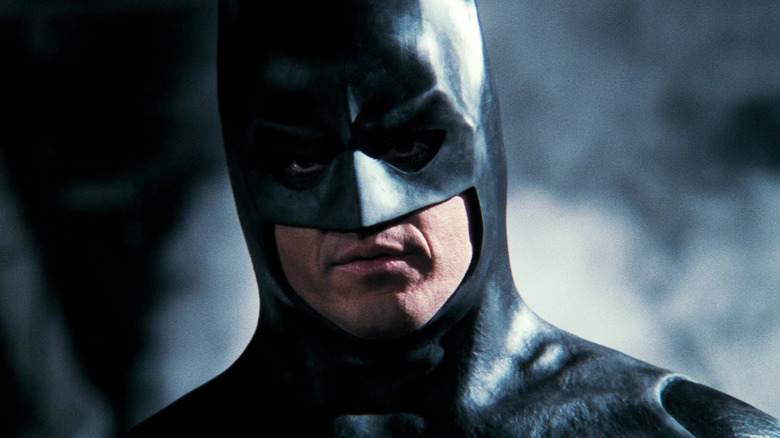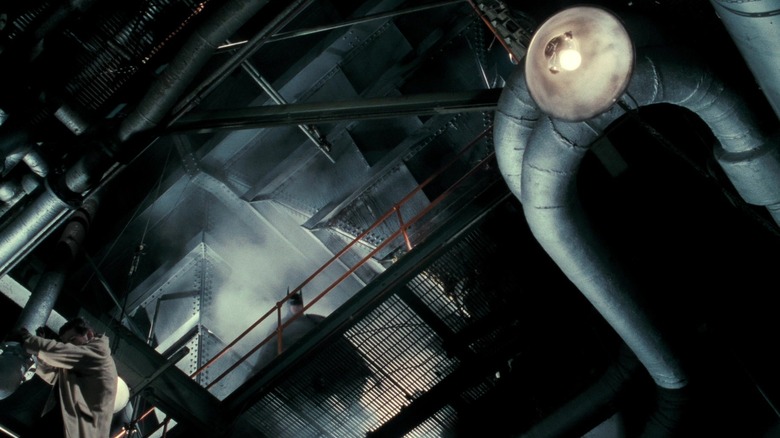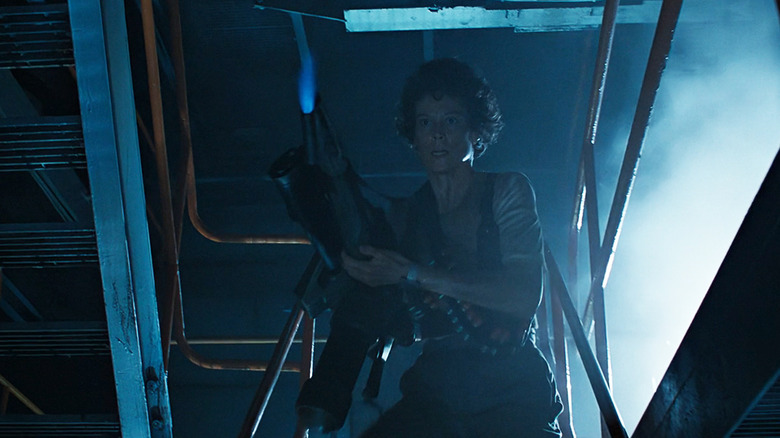Two Of The Best Blockbusters Of The '80s Filmed At The Same London Power Station
When Tim Burton signed on to direct "Batman" in 1989, he wasn't prepared for the absolute torture he'd have to go through while making the film. The director was essentially still a newcomer, having only made "Pee-wee's Big Adventure" and "Beetlejuice" before taking on what would prove to be a major blockbuster in "Batman." As such, his experience making the 1989 movie was nothing short of a baptism of fire. Not only did he have to constantly battle Warner Bros. to maintain his artistic vision and retain key parts of his and Sam Hamm's script, but he oversaw grueling shoot schedules that involved filming six days a week, usually until 5:00 or 6:00 a.m. Adding to the pressure was the fact that casting Michael Keaton as Bruce Wayne/Batman resulted in a controversy that had Burton fighting for his leading man.
With all that in mind, it's no wonder the director chose to film "Batman" across the pond, away from the backlash and studio execs. The production base was England's Pinewood Studios, where production designer Anton Furst erected huge Gotham City sets, some of which were 600 feet high. It was in this fabricated Gotham that Burton and the team shot almost the entirety of the film, only venturing out for a handful of scenes and establishing shots.
One major location that wasn't part of Furst's industrial nightmare sets was Axis Chemical, in which Jack Nicholson's Jack Napier is transformed into the Joker. This entire scene was shot at London's Acton Lane Power Station, where it turns out another '80s blockbuster had not only shot, but had left behind entire sets for the "Batman" team to find.
Axis Chemicals in Batman was shot in a real-life power station
Acton Lane Power Station, which had opened back in 1899 and was shuttered in 1983, was the perfect fit for "Batman." Its somewhat dilapidated industrial interior melded perfectly with Anton Furst's production design and seemed to perfectly fit Tim Burton's vision for a darker Dark Knight. As such, the director made more use of Acton Lane than any other non-Pinewood based set.
In the film, Jack Napier arrives at the chemical plant with his goons only to realize he's been set up by mob boss Carl Grissom, played by Hollywood legend Jack Palance (who at one point yelled at Burton on the set of "Batman"). After police arrive to take Napier into custody, Batman descends to try to take down Napier and his gang, but ends up accidentally causing a bullet to ricochet off his forearm gauntlet and into Napier's face. Napier then falls from a balcony into a vat of chemicals, thereby transforming into the Clown Prince of Crime.
Axis shows up several more times in the movie as the base of operations for producing Joker's poison cosmetics, before Batman blows up the whole thing with a grenade delivered via Batmobile. Acton Lane was therefore a particularly important location for the production, even if it didn't form part of the expansive and impressive Pinewood set. But when the "Batman" crew showed up at Acton, they found the remains of another film set already in place: The Xenomorph hive from "Aliens."
The Xenomorph hive is where the Joker was born
In James Cameron's 1986 sequel to Ridley Scott's "Alien," Sigourney Weaver's Ellen Ripley joins a team of colonial marines as they investigate the exomoon LV-426, where a terraforming colony has gone dark. Once there, they find the colony abandoned and infested with Xenomorphs, who have created a hive in the depths of a processing station, home to the Xenomorph Queen (who was a lot harder to create than you might think). This hive was created in Acton Lane Power Station in 1985, which, just like with "Batman," was a perfect match for the aesthetic of the film.
Of course, the "Aliens" production team had to dress up the property much more than Burton and company. After clearing the location of asbestos, the "Aliens" crew filled the power station with resin and eggs, alongside several models of colonists who had been captured by the Xenomorphs and suspended in the resin lining the walls of the processing station. But several key characteristics of Acton Lane Power Station were still visible in the movie, including the red railings that lined the walkways. These can also be seen in multiple times in the Axis Chemical scenes from "Batman," and the stairs Ripley walks down are the same ones Jack Nicholson's Jack Napier uses when trying to escape a firefight.
Interestingly enough, a prop seat used in "Aliens" also made its way into "Batman." The M577 APC interior set from "Aliens" included a seat that was, as confirmed by users of the RPF forum, a pilot chair taken from a 1960s-era Trident jet. This same chair appears to have been reused as the seat Michael Keaton's Bruce Wayne uses in the Batcave. It's not clear whether the "Batman" crew found the chair at Acton Lane or whether it was left behind at Pinewood Studios, where "Aliens" also shot. But clearly, Tim Burton and Cameron's movie shared a similar aesthetic, and considering Burton was under the pressure he was, why not make things easier where possible?


